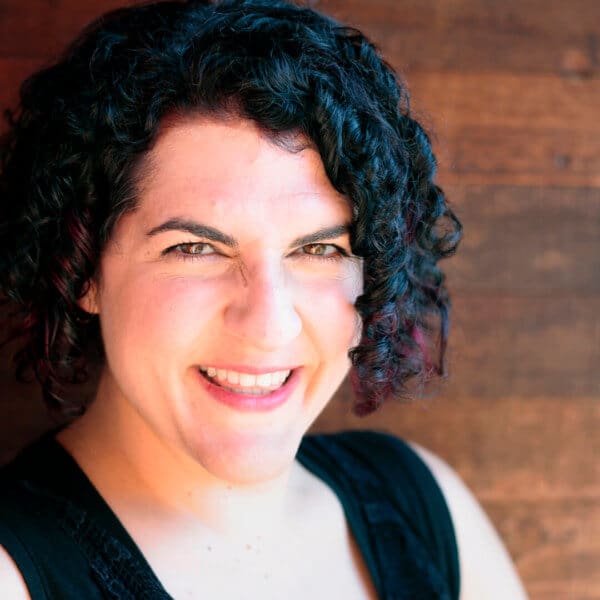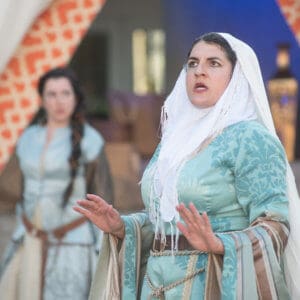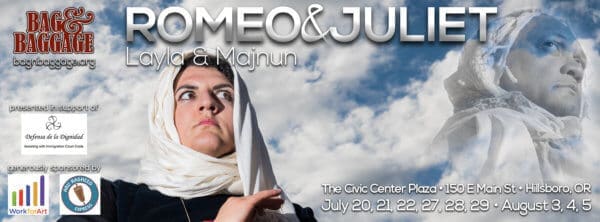- Skip to primary navigation
- Skip to secondary navigation
- Skip to main content
- Skip to primary sidebar
The Familiar Made Strange and Vice-Versa: Mandy blogs on Romeo & Juliet
 The script we’re working on for this production is a seamless blend of Shakespearean verse (Romeo and Juliet) and translated Persian verse (Nizami’s Layla and Majnun). In putting together his script, Scott included most of the “greatest hits” of Romeo and Juliet; I’m sure large swaths of our audience will recognize, say, the section between “But soft! What light through yonder window breaks?” and “Parting is such sweet sorrow, that I shall say goodnight till it be morrow.” R&J has particular narrative milestones, like that famous balcony scene, which have pretty iconic pieces of text associated with them. Those moments have even been mixed into popular culture, referenced in novels, sitcoms, musicals… However, the words between those most famous moments are likely much less familiar to the general public, except to scholars, R&J fans, or people who’ve been in the play before.
The script we’re working on for this production is a seamless blend of Shakespearean verse (Romeo and Juliet) and translated Persian verse (Nizami’s Layla and Majnun). In putting together his script, Scott included most of the “greatest hits” of Romeo and Juliet; I’m sure large swaths of our audience will recognize, say, the section between “But soft! What light through yonder window breaks?” and “Parting is such sweet sorrow, that I shall say goodnight till it be morrow.” R&J has particular narrative milestones, like that famous balcony scene, which have pretty iconic pieces of text associated with them. Those moments have even been mixed into popular culture, referenced in novels, sitcoms, musicals… However, the words between those most famous moments are likely much less familiar to the general public, except to scholars, R&J fans, or people who’ve been in the play before.
Anytime I go to the theater to see a play that I’ve read in a text version, even a play with which I fancy myself to be very familiar, I’m pretty much always surprised to discover scenes and passages that seem entirely new to me, as if I’d never encountered them before. Just watching the text come to life onstage makes me see words, characters, and scenes in a new light, in a way I hadn’t considered when reading them on my own—and that’s without any text changes from the author’s original.
One of the things I find most delightful about our script is that even with the first words spoken onstage, an audience familiar with the original R&J will realize that it’s not going to be just R&J in a new treatment—it’s already a fundamentally different play. Those who arrive familiar with the Nizami will likely also have their expectations in tow. Prepared for two texts both alike in dignity, audience members may also carry expectations of the mysterious other unknown or lesser-known text. Hopefully, watching the script as it actually exists will disrupt preconceived notions, such that each person in the audience will watch the rest of the show with a fresh awareness: Do I recognize this part? How about this part? Is this really what happens next? Wow, that’s a beautiful line…wait, have I heard it before? Was that line written by Shakespeare…or wasn’t it?
Working on this play has made me think of the parallels between this theatrical blend of cultures and of my own upbringing in Southern California with a dad from Tehran and a mom from Michigan. We spent a lot of time with Farsi-speaking friends and relatives, and not all the people living in our house could speak English. Across our Persian friends and relatives, there were several wide, overlapping spectrums of language, religion, and culture. There was a wide spectrum between those who pretty much only spoke English (my sister and I) through our parents and many friends and relatives who spoke both, to people like our grandma (whom we called Maman) who pretty much only spoke Farsi. Some of our relatives (Maman) were devout Muslims, some were not. Some went back and forth to Iran all the time; some lived only in the US (or England, which is a whole other cultural difference). But the language/religion/culture spreads could not predict who was kind, who was eccentric, who was a brat, who told good jokes, who remembered details about your life, who was politically conservative or liberal, who was a poet or an artist, who loved the Rat Pack and Julie Andrews (Uncle Amir)…you know, human stuff. There were just, sort of, two kinds of normal. The Persian side of our family was just as weird or normal as the side from Michigan, and just as hard or easy to talk to (regardless of how many words in common languages we shared).

In Shakespeare’s version of Romeo and Juliet, the lovers are doomed because their families are feuding; they’ve created difference among people who are culturally the same as each other, and the moral is essentially, “See what happens when we decide not to get along?” In this hybrid version of Shakespeare’s script and his original inspiration text, the two central families are culturally different—but not necessarily totally at war with each other in the beginning. Individual actions set the story in motion, in a way that makes this plot feel more tragic to me than R&J, because the motivations for the characters’ actions are more complicated. How much does religion, or language, or culture, affect the actions of the individuals in the play? How much would they be able to overcome their grand-scale cultural differences if not for the more petty and human problems caused by the petty and human characters who make rash decisions? Our version of the story seems much murkier to me, at least from inside the script, and it’s less clear who is doing the “right thing.”
Two plays here come together into their own unique story; my hope is that the audience’s experience of this story will make them examine what they thought they knew about Shakespeare’s Romeo and Juliet, about Nizami’s Layla and Majnun, about Persian culture, about their immigrant friends and neighbors from all over the world, and about what makes us as humans more familiar to each other, rather than strange.
Mandy Khoshnevisan
Lady Capulet


Reader Interactions